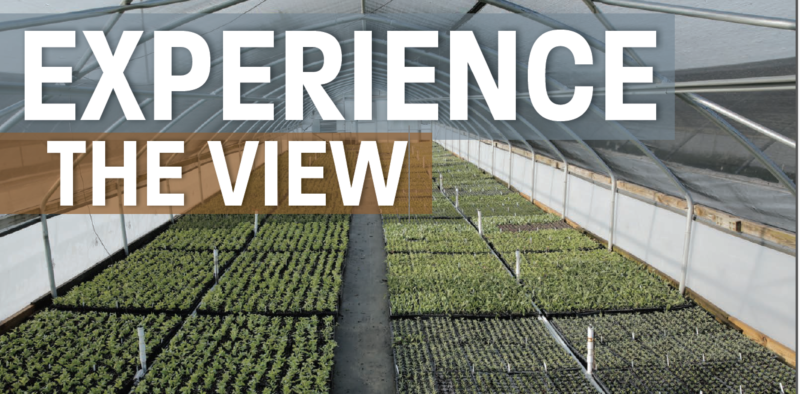
Cover Story — Experience the View
For Lyndsi Oestmann and her 150-member team at Ottawa, Kansas-based Loma Vista Nursery, the view from here is pretty good.
Oestmann is the second-generation owner of the company founded by her dad, Mark Clear, in 1991. Today — as the company prepares for its 30th anniversary — Oestmann has the reins of the company and is grateful to the industry that is her dad’s passion, and hers as well. 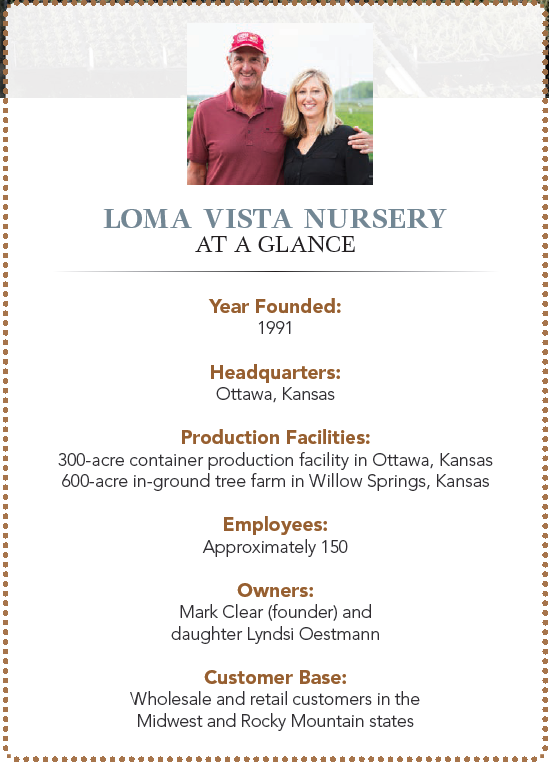
KEEPING IT SUSTAINABLE … AND CLEAN
Within the last two years, the company has cultivated an award-winning environmental sustainability initiative, provided a leadership model for successful Systems Approach to Nursery Certification (SANC) and developed an enviable internship program that provides hands-on training to new industry professionals.
Loma Vista Nursery’s keys to success belong to its skilled and cohesive staff, commitment to continual education and service training, and a management philosophy based on good old-fashioned family values. “There’s no team you can be on where you put the needs of yourself in front of those of the team,” says Oestmann. “Our legacy as a company is to always stretch to do better.”
The company propagates, grows and nurtures each generation of its Midwest-hardy crops — on more than 900 combined acres of rolling, loam-rich Kansas soil. Product is grown in a four-season climate that provides the ideal environment for producing weather-tested plant material. The nursery then ships to wholesale and retail customers in the Midwest and Rocky Mountain states.
Loma Vista Nursery’s tree farm — dubbed “Field of Trees” — sprawls 600 acres about 20 miles north of Ottawa, in Willow Springs, Kansas. Production includes field-grown shade and ornamental trees, upright junipers and spruce and other deciduous and evergreen varieties.
Clean cultivation is practiced throughout the site, which helps prevent pests and diseases. For uniform airflow and consistent coverage, the nursery is treated with an electrostatic mist blower. Providing streamlined and continuous direct spray, less chemicals are used and machine turbulence is reduced, creating a safer environment and alleviated risk to employees.
At its 300-acre container facility in Ottawa, the company produces more than 2 million pot-in-pot trees, shrubs, roses, grasses, perennials and groundcovers.
“The team propagates more than 80% of Loma Vista Nursery’s container shrubs and grows close to 200 perennial varieties,” Oestmann says.
It pots up, on average, 20,000 plants per day using two state-of-the-art potting machines — from 1- and 2-gallon containers up to 30 gallons.
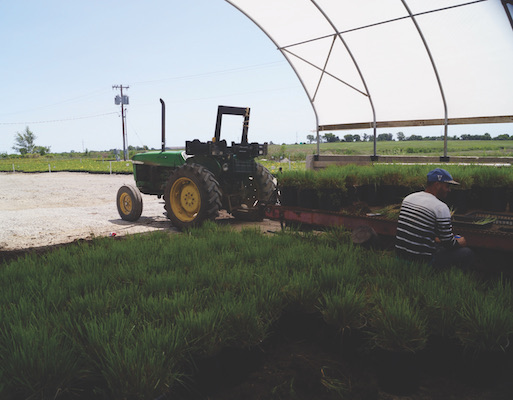
Built on an old rock quarry, the facility includes 150 cold-frame overwintering houses that span about half the irrigated production space. Each cold frame features custom options tailored to the needs of specific plants. An additional large structure provides shelter for hostas and other shade perennials, with another housing boxwood and yews for current and future demands.
Both shade structures were built in-house and are equipped with roll-back tops and sides to allow for sunlight and air flow.
The entire container facility is supported environmentally by a 40-acre, 80-foot deep irrigation pond, (the nursery’s primary water source), and if necessary, could supply the operation for at least two years. When the nursery was originally constructed, large drainage pipes were installed underground that flow back to the reservoir and recapture about 80% of the nursery’s irrigation water.
“The company felt it was the responsible thing to do,” says Duane Huss, operations manager. “We’re contributing to other waste management initiatives as well, trying to keep stuff out of the landfill. We’re recycling cardboard, plastics and we’ve set up recycling initiatives in each of our offices — encouraging everyone to make the environmental and socially responsible choice.”
A SYSTEMS APPROACH
Plant health and wellness are hallmarks of the grower, making it one of the first to participate in Systems Approach to Nursery Certification (SANC) and then receive certification in 2018. SANC is administered by the National Plant Board, a non-profit organization that includes plant pest regulatory agencies representing each state, Puerto Rico and Guam. The certification process is voluntary, audit-based and designed to reduce pest risks associated with movement of nursery stock.
Working with their state agency, growers create a customized plan that addresses identified pest risks and maintains records of what is done. A subsequent audit assesses the grower’s plan and provides checks to identify if the plan is working. SANC also provides transparency and trust with a nursery’s state ag department. Loma Vista Nursery’s SANC Manual is now part of its daily business and drives its training sessions for new employees.
“Each member of the team has responsibilities to SANC that are critical to the health of our plants and the success of our nursery,” Oestmann says. “They have always had those responsibilities, but with the level of SANC training we now administer, they are stated front and center. Everyone knows what they need to do and does it.”
GROWING THE TEAM
A byproduct of the SANC process is the development of a close-knit, intergenerational team that thrives on mentoring and growing the professional training of one another.
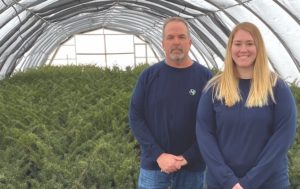
“You always want to do your best, care about what you’re doing and care about the people you work with,” Huss says. “Loma Vista Nursery is not big and it’s not small — but we are always striving to be better through internal and external education and training initiatives that provide growth for employees. In doing so, Loma Vista Nursery retains its employees because they are motivated and challenged and they want to come to work every day.”
Brooke Stamm, who earlier this year received the Emerging Leader Award from the Western Nursery & Landscape Association, is an example of that philosophy in action. Stamm began as an intern in 2015. Today, she is propagation manager and perennial grower leading a team of up to 15 professionals.
“With Duane and the team we’re constantly learning from one another,” Stamm says. “This is a really good place to thrive in your career. We’re given all the right tools and people to help us each succeed. It’s a really good support system to have.”
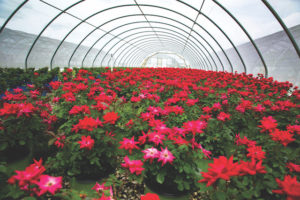
Every summer, the nursery hires up to four college interns who receive college course credit, an hourly wage and housing, and spend the summer doing hands-on work.
They shadow members of each team and experience every aspect of the operation, from propagation all the way through shipping and quality control. Interns also attend Cultivate in Columbus, Ohio, to network and learn from other professionals.
They also participate in community service projects and other field trips. It’s an experience interns say they find invaluable to help identify their career goals. Oestmann says managers and staff likewise learn from the interns.
ALL STAR ROOTS
“We appreciate being involved in an industry where so much sharing happens, and where businesses are willing to work together,” Oestmann says, citing several occasions where Loma Vista Nursery has opened its doors to nurseries needing ideas or best practice advice, and vice versa.
“I grew up at the nursery,” Oestmann says, “and through the years I have worked almost every job that we have here. I had a lot of experience working in the company as a kid and I also saw both my parents work the business. I saw what that entailed and the commitment that it took.”
Oestmann’s father, Mark Clear, was a twotime All-Star major league baseball relief pitcher for three different teams. He “grew up working on an avocado ranch owned by a friend’s parents,” Oestmann says. “They started Loma Vista Nursery together in 1979 in Southern California.”

As the family moved around the country with his baseball career, Loma Vista Nursery continued as a thriving independent garden center in Yorba Linda, California. In 1991, Clear sold his interest, brought one of the original nursery vehicles with him across the country and moved his family to Olathe, Kansas, and founded his new company.
“My brother and I would ride the bus home to the nursery every day as my parents were working tirelessly to start the company,” Oestmann says. “It was very different for me because we had become used to moving around a lot with my dad’s job. Now we were in a spot where we were going to stay. I planted one of the company’s first crops of trees. I worked in our accounting office through high school. But my favorite thing was when I worked in field operations — pruning and taking suckers off trees all day. I really liked that.”
CONSUMER CONNECTION
In 2020, the Loma Vista Nursery team is looking forward to the promise of a rewarding growing year. Already, top sellers for spring 2020 are hydrangea, small arborvitae evergreens, grasses and boxwood.
Consumer education and an eye on trends remains critical as the company targets its plants to end-users of all ages and experience. “We’re educating consumers that you can go to the grocery store and buy hydrangea stems for $20,” Oestmann says, “but if you plant a hydrangea in your yard, you could have a hundred flowers and use those cuttings in your centerpiece over and over again throughout the season for what amounts to far less. Same with grasses. Take them from your yard, dry them out and enjoy them in your home.”
Plant-parenting outdoor succulents, perennials and shrubs, Stamm predicts, will take the indoor houseplant trend of last growing season outdoors in the months ahead. She suggests that locating the right plant in the right place is still the No. 1 tip for any newbie plant parent.
“Make sure you use pots that are well drained, so you don’t develop root diseases or drown the plant. Flowering shrubs can be great additions to the plant-parent palette — and can be brought indoors after the growing season,” Stamm says. “Plant them in a pot in the spring, transplant them to your landscape bed in the fall and enjoy cut flowers from them for years to come.”
“These are perfect trends for us because we are growing plants that will live in Midwest landscapes,” Oestmann adds, “tested in our weather for blooming nine to 10 months out of the year, from April through frost-freeze. That’s incredible value for the long term.”
The outlook for Loma Vista Nursery in the coming seasons will undoubtedly include leadership challenge and perspective. Asking questions, learning from one another and managing best practices will continue for the grower as the industry evolves and establishes new technologies.
“Every plant in our nursery and every person in our company has a purpose,” Oestmann says. “Both are centered on growing.”


 Video Library
Video Library 




















